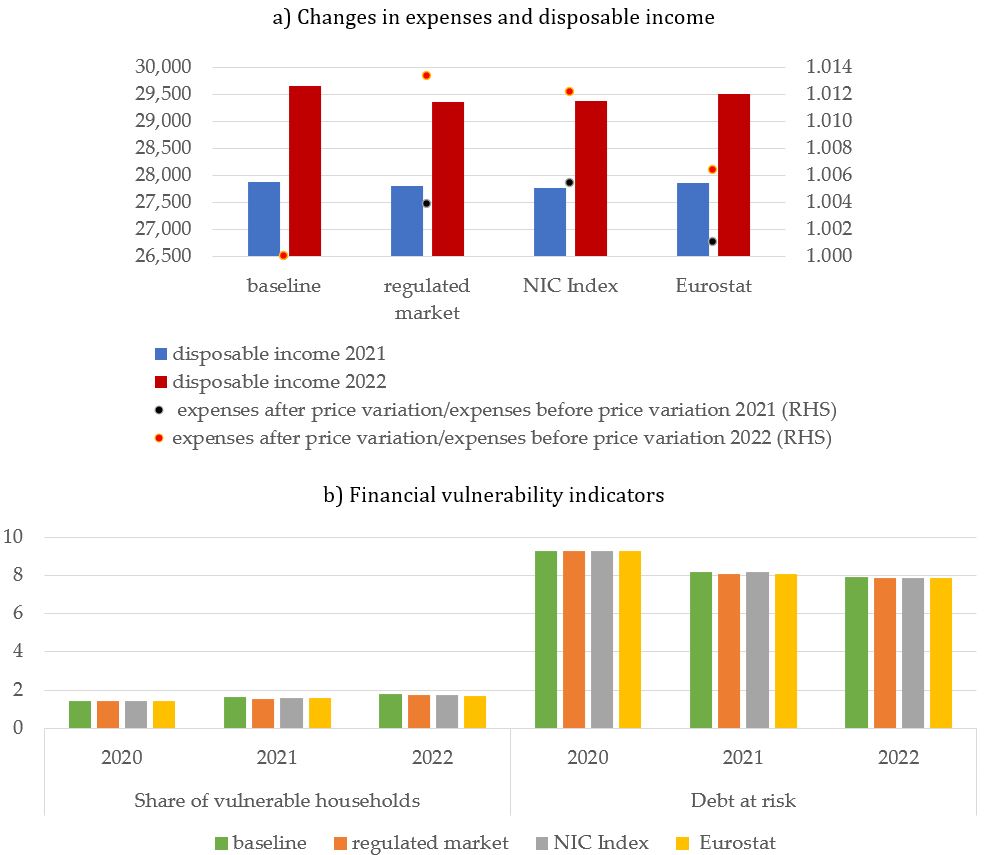

This policy brief should not be reported as representing the views of the Bank of Italy. The views expressed are those of the authors and do not necessarily reflect those of the Bank of Italy.
What was the impact of the energy price upsurge in 2021-22 on households’ financial vulnerability? Colabella et al. (2023) present an assessment based on Italian households, exploiting Bank of Italy’s microsimulation models coupled with a detailed set of energy price elasticities. The results show that the indicators of households’ financial vulnerability have remained rather low and in line with actual data, as per banks supervisory reports. This happens only when households’ financial vulnerability accounts for consumption rebalancing within a dynamic microsimulation model. In contrast, if the assumption prevalent in the literature holds true, i.e. households’ expenditure does not readjust to energy price spikes, financial vulnerability overshoots official data. While the results indicate that the risks for financial stability associated with the impact of energy shocks on Italian households were limited, this has occurred at the expense of household consumption and overall welfare.
At the beginning of 2021, energy prices rose on the heels of a combination of supply and demand factors. This structural increase was compounded by the Russian invasion of Ukraine on 24 February 2022, which resulted in an abrupt spike in energy prices on the global markets similar to that observed during the oil shocks of the 1970s. On Italian markets, gas and electricity prices skyrocketed. These abrupt price increases struck households unevenly, affecting especially those that spend a greater share of their budget on energy or with a higher average propensity to consume (Curci et al., 2022; Faiella and Lavecchia, 2022; Guan et al., 2023). By eating away at households’ purchasing power, price hikes ultimately reduce disposable income, hampering households’ ability to repay their debts. Depending on the amount of strain placed upon families, the latter could become more financially vulnerable and risks to financial stability could materialize.
This brief investigates to what extent energy price hikes affect the financial vulnerability of Italian households. We show that by not taking into account behavioural responses (i.e. assuming price inelasticity, a common postulation in the literature), households’ financial vulnerability may be significantly overestimated. Conversely, by taking energy demand price elasticities into due account along with the evolution of the relevant macro variables, we find that the increase in the number of vulnerable households (and their associated indebtedness) is comparable to the rise that would occur in a scenario where energy prices do not change. This is because households readjust their energy consumption (i.e., they trim their use of electricity and heating) to maintain disposable income as unchanged as possible, so that it can be used to service their debt. This is not a free lunch, though: in fact, households forgo part of their energy comfort to keep within their budget constraints.
Understanding how household energy markets work in Italy and which data are available is key to laying the ground for the analysis. Retail gas and electricity markets both have a two-tier structure. In each segment the price of the energy component is determined according to specific rules. On the regulated market (“Mercato di Maggior Tutela”), the price of the energy component is set by the Italian Regulatory Authority for Energy, Networks and the Environment and updated quarterly.1 On the free market (“Mercato Libero”), the energy price is determined by market rules. In this market contracts can have different price setting mechanisms and length. By the end of 2022, nearly 70 percent of electricity and gas purchased by households came from operators in the free market. Unfortunately, granular data on contracts are not available yet, and price frequency is limited to half-yearly averages. To deal with these data shortcomings we follow Faiella and Lavecchia (2021): we first determine price elasticities of electricity and heating for 36 different household groups (strata) applying a quasi-panel approach on the Italian Household Budget Survey (HBS) data. Then we shock energy prices under different scenarios and model households’ consumption bundle adjustment accordingly: the adjustment is stratum-specific and reflects both households’ characteristics and consumer preferences on the item shocked prevailing at each level. We find that, on average, households’ price elasticity is smaller (in absolute value) for electricity than for heating. Moreover, for electricity the elasticity decreases in absolute value is lower for more affluent households; the opposite is true for heating. Finally, both for electricity and heating, households with 3 or more children across all the income distribution are more sensitive to price increases, as well as poor singles.
To dig further into the issue of financial vulnerability of households in Italy, we exploit to their full extent the microsimulation models developed at the Bank of Italy (Michelangeli and Pietrunti, 2014; Attinà et al., 2020) and we extend them to take into account the changes in energy consumption resulting from the energy price shocks.
In particular, applying a methodology in line with Faiella et al. (2022), we combine the consumption adjustment calculated in the previous stage with microdata from the Bank of Italy’s 2020 Survey on Household Income and Wealth (SHIW), and calculate the adjusted households’ disposable income which reflects changes in consumption induced by the energy price shocks. We hold that household disposable income diminishes proportionately to the increase in energy expenditure, if any. Households’ ability to repay their debt is affected by the reduced disposable income.
We assess the impact of energy inflation shocks on households’ vulnerability with and without a behavioural response (i.e. a consumption adjustment) exploiting both a static and a dynamic microsimulation model. We assume that in a baseline case there are no energy-induced price shocks. We then consider three alternative scenarios, which differ with respect to data used to measure the energy price increase observed between 2020 and 2022 (Table 1): “Mercato di Maggior Tutela”, the electricity and natural gas components of the NIC Index (Istat’s consumer price index for the entire national community), and the weighted average unit cost of energy from Eurostat. We apply the price increase indistinctly to all households; the exercise, therefore, establishes by construction an upper bound for their financial vulnerability. The results can also be interpreted as stemming from a stress test.
Table 1: Cumulated price variations (2020-2022)

Notes: results are in percentage points for cumulated percentage variations, euro/kWh for electricity and euro/Gj for natural gas in the case of absolute variations. As the NIC is an index, we calculated the overall percentage variations and applied them to the Eurostat value as of December 2020.
We start our exercise by running a series of static simulations, focusing on households’ characteristics in 2020 and applying the cumulative energy price variation (in absolute terms) to reduce disposable income for the 2020-22 period, with and without accounting for price elasticity. In the baseline scenario, the share of vulnerable households in the population is 1.5 per cent and their debt amount (debt at risk) is 9.2 per cent of households’ total financial obligations.
Assuming perfect inelastic demand, energy expenditure rises proportionately along with prices. This leads to a proportionate decrease in disposable income and a consequent increase in financial vulnerability. The highest increase in fragility is recorded under the NIC and regulated market scenarios, where in both cases the share of vulnerable households and that of their debt at risk reach, respectively, 1.8 and 10.7 per cent (an increase with respect to the baseline of 26 and 17 per cent, respectively; Fig. 1). The rise in vulnerability, however, does not match with other financial evidence based on supervisory reports, according to which the household new non-performing loan rate does not spike following the energy price shock.
Figure 1: Static model, no price elasticity: aggregate results

Notes: Panel (a) shows households’ expenses after the energy price shock as a multiple of expenses before the shock and the average disposable income. Disposable income is in euros. Panel (b) reports the share of vulnerable households and their debt at risk. Results are in percentage values.
We then extend our static setup to include energy price elasticities. Focusing on the NIC Index, which features the greatest price variation, financial vulnerability remains about the same as in the baseline scenario (Fig. 2), as the increase in energy prices induces households to change their consumption, reducing the quantities consumed and limiting the impact on disposable income.
Figure 2: Static model, with price elasticity: aggregate results

Notes: Panel (a) shows households’ expenses after the energy price shock as a multiple of expenses before the shock and the average disposable income. Disposable income is in euros. Panel (b) reports the share of vulnerable households and their debt at risk. Results are in percentage values.
We then exploit to their full extent the microsimulation models, allowing income, debt and consumption to evolve over time in line with macroeconomic data and projections (dynamic setup). Throughout all the scenarios under consideration, the share of vulnerable households and the debt at risk appear to be very similar to those prevailing in the baseline scenario (Fig. 3). This confirms that vulnerable households adjust their consumption expenditure in such a way as to maintain the level of disposable income as stable as possible and to preserve their capacity of debt repayment. At the same time, this occurs at the expense of household consumption and overall welfare.
Figure 3: Dynamic model, with price elasticity: aggregate results

Notes: Panel (a) shows households’ expenses and the average disposable income. Disposable income is in euros. Panel (b) reports the share of vulnerable households and their debt at risk. Results are in percentage values.
Attinà, A., F. Franceschi, and V. Michelangeli (2020). Modelling households’ financial vulnerability with consumer credit and mortgage renegotiations. International Journal of Microsimulation 13 (1), 67–91.
Curci, N., M. Savegnago, G. Zevi, and R. Zizza (2022). The redistributive effects of inflation: a microsimulation analysis for Italy. Questioni di Economia e Finanza (Occasional Papers) 738, Bank of Italy, Economic Research and International Relations Area.
Faiella, I. and L. Lavecchia (2021). Households’ energy demand and the effects of carbon pricing in Italy. Questioni di Economia e Finanza (Occasional Papers) 614, Bank of Italy, Economic Research and International Relations Area.
Faiella, I. and L. Lavecchia (2022). Contenimento dei prezzi dell’energia e spesa delle famiglie. Energia 1 (1), 36–39.
Faiella, I., L. Lavecchia, V. Michelangeli, and A. Mistretta (2022). A climate stress test on the financial vulnerability of Italian households and firms. Journal of Policy Modeling 44 (2),396–417.
Guan, Y., J. Yan, Y. Shan, Y. Zhou, Y. Hang, R. Li, Y. Liu, B. Liu, Q. Nie, B. Bruckner, et al. (2023). Burden of the global energy price crisis on households. Nature Energy 8 (3), 304–316.
Michelangeli, V. and M. Pietrunti (2014). A microsimulation model to evaluate Italian households’financial vulnerability. International Journal of Microsimulation 7 (3), 53–79.
This represents only a portion of the total price paid by customers. Approximately 60 percent of the final price comprises network and transport tariffs, VAT, and other levies (such as support for Renewable Energy Sources).